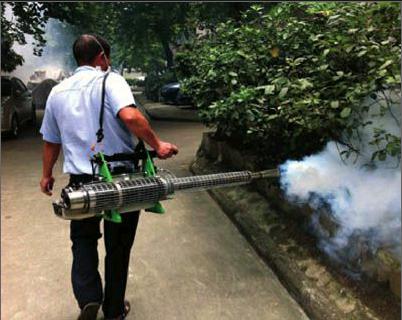Dealing With Dengue
2014-12-01ByYinPumin
By+Yin+Pumin

South China is suffering from its worst outbreak of dengue fever in two decades, with 1,000 new cases of the potentially fatal mosquito-borne disease emerging each day, according to local media reports.
In Guangdong Province alone, the total number of dengue fever cases had reached 42,856 by November 1, according to the provincial health and family planning commission. The disease has been detected in 20 out of 21 prefecture-level cities in the province and six people have died from the virus, according to the commission.
Even worse, another 22 areas including Zhejiang, Fujian, Yunnan provinces and Guangxi Zhuang Autonomous Region have also detected dengue cases numbering into the hundreds this year, according to the National Health and Family Planning Commission (NHFPC).
“The outbreak of dengue fever this year is the worst in China since 1995, when 6,812 cases were recorded,” said Qin Chengfeng, a researcher with the Chinese Academy of Military Medical Sciences. “But as the disease can be prevented and treated, there is no need to panic,” Qin added.
Low-profile
Early in April, Chinas top health authority issued a public alert for dengue fever. Dengue fever generally hits tropical and sub-tropical regions. Symptoms include fever, nausea, rashes, backache and headaches. The hemorrhagic variant, which causes severe internal bleeding as blood vessels collapse, is often fatal.
The WHO has also warned that dengue fever is becoming a potential threat to the world, maybe in part because of its obscurity among the public. According to the WHO, dengue fever is the fastest growing vector-borne disease—meaning that it is transmitted to humans from an organism that acts as a carrier—having registered a 30-fold increase in cases recorded globally, in just 50 years.
More than 40 percent of the worlds population is now at risk from dengue fever and there are about 100 million cases each year worldwide, the WHO estimates.
The Asia-Pacific region is particularly vulnerable, bearing up to 70 percent of the disease burden, according to the data platform DengueNet.
“South China covers the tropical and subtropical regions that are breeding grounds for the virus,” said Liu Qiyong, a senior specialist at the Chinese Center for Disease Control and Prevention (CDC). He attributed the outbreak of dengue fever to high temperatures and wet weather in the region, where the mosquito population has been five times the normal level.
“Rain is frequent. Puddles can be seen everywhere, providing a favorable environment for mosquito incubation and growth,” he said.
He Jianfeng, chief expert with the Guangdong Center for Disease Control and Prevention, agreed. “Guangdong is a place with abundant rain in the summer. Under these conditions, dengue fever usually peaks in the province between May and November,” he said.
Meanwhile, Liu warns that the huge tourist inflow from neighboring countries and regions, also under threat from the virus, may worsen the situation in the region.
“Guangzhou is an international city that sees a considerable inflow of foreign nationals every day. Most of these people are from South and Southeast Asia where dengue fever also prevails. It makes it more difficult for us to contain the disease,” Liu said.
As of September, Malaysia had reported 53,000 cases of dengue fever, the Philippines 30,000 cases, Singapore 14,000 cases, Thailand 19,000 cases and Japan over 100 cases, according to reports.
Japan, usually not affected by dengue fever because of its cool climate, reported its first outbreak of the disease in 70 years, likely due to climate change, experts said.
“Global warming has expanded the traditional habitat of the types of mosquitoes that carry and spread infections, putting more people at risk of contracting dengue fever,”Liu said.
Climate change aside, there is another new factor relevant to the growth of dengue fever in China—fast urbanization, according to Liu.
“Combination of ‘rampant urbanizationand increasingly severe weather events like cyclones and tropical storms have conspired to create the ideal conditions for tropical disease,” Liu said.
The specific species of mosquito that transmits dengue cant fly very far and so the virus thrives in densely populated cities and towns. Moreover, concretization of large spaces in China is reducing water run-off, boosting urban flooding and providing new breeding sites for mosquitoes.
Worse, the CDCs current monitoring efforts still has blind spots, making it difficult to accurately assess the risk, provide alerts and make timely and accurately intervention plans, he said.
The center has begun monitoring major vector-borne diseases in 19 provinces. Moreover, public awareness needs to be improved, he said. Individuals traveling to infected areas or countries should take precautions against infection to avoid bringing the infections home. At state level, effective intervention requires cross-border cooperation, he added.
Seeking measures
Facing a serious situation, Chinese health authorities started a campaign against the disease at the end of September. The NHFPC called for efforts to cut the number of mosquitoes, which included sealing puddles of stagnant water—popular breeding grounds for the insects. It also suggested people wear trousers and long sleeves to cover their skin.
“We have also set up a joint mechanism with Hong Kong and Macao exchanging information every day,” said Song Shuli, a spokeswoman of the NHFPC, at a press conference.
In Guangdong, to prevent and fight the epidemic, a special task force headed by Vice Governor Lin Shaochun has been established to focus on dealing with dengue fever cases.
Guangzhou, the capital city of the province, has begun distribution of free mosquito repellent and handouts on mosquito control. The citys disease control center has set up over 450 monitoring stations.
The water bureau in Guangzhou has also reacted to the disease by adding fish that feed on mosquito larvae into stagnant waters to combat the surging mosquito population.
Residents of the city have also vowed to fight the disease, with thousands of people working to clean potential mosquito breeding sites every Friday afternoon since July. The action is planned to last till November.
Community workers have visited households to distribute chemicals for killing mosquitoes, to spray pesticide and to help empty containers with stagnant water.
Meanwhile, Liu with the CDC urged people to pay attention if they show flu-like symptoms such as high fever, nausea and headaches, lest they forgo treatment.
Health experts warn seniors with chronic diseases are more vulnerable to the virus. According to Yin Chibiao, President of Guangzhou No.8 Peoples Hospital, more than 50 percent of the seriously ill dengue fever patients treated at his hospital are older than 60, with 20 percent older than 80.
Thanks to all these efforts, fewer new cases of dengue fever have been reported in Guangdong since mid-October, a signal that the virus is gradually abating as the weather cools, according to the local health authorities. Experts predicted that the epidemic may come to an end in early December.
